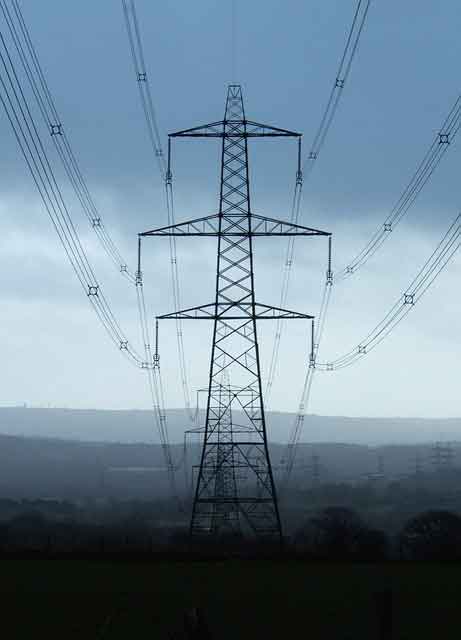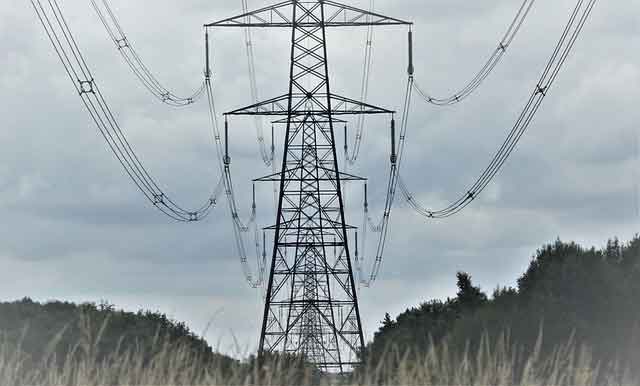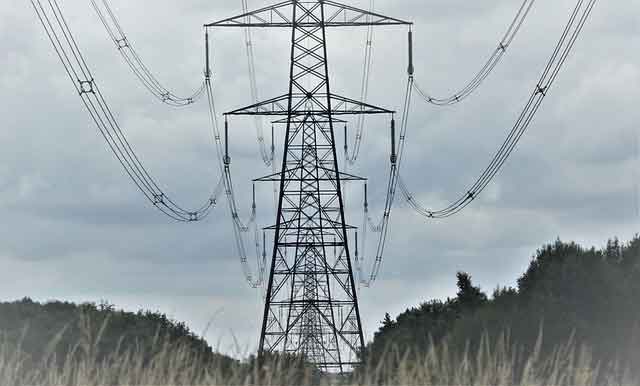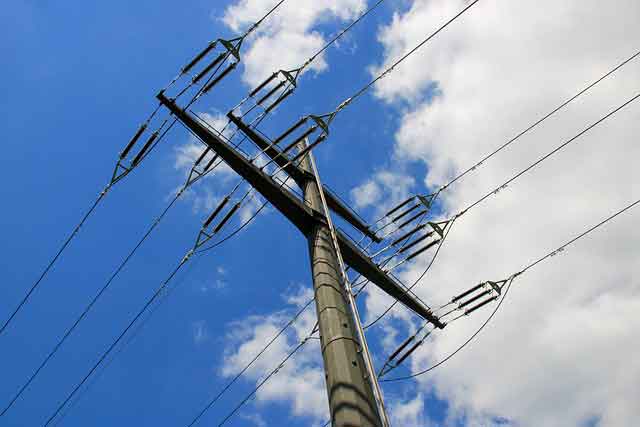Latest Electricity News - Climate Change

Cannes Film Festival Power Outage Under Investigation
Cannes Film Festival Power Outage disrupts Alpes-Maritimes as an electrical substation fire and a fallen high-voltage line trigger blackouts; arson probe launched, grid resilience tested, traffic and trains snarled, Palais des Festivals on backup power.
Key Points
A May 24, 2025 blackout in Cannes disrupting events, under arson probe, exposing grid risks across Alpes-Maritimes.
✅ Substation fire and fallen high-voltage line triggered blackouts
✅ Palais des Festivals ran on independent backup power
✅ Authorities probe suspected arson; security measures reviewed
A significant power outage on May 24, 2025, disrupted the final day of the Cannes Film Festival in southeastern France. The blackout, which affected approximately 160,000 households in the Alpes-Maritimes region, including the city of Cannes, occurred just hours before the highly anticipated Palme d'Or ceremony. French authorities are investigating the possibility that the outage was caused by arson.
Details of the Outage
The power disruption began early on Saturday morning with a fire at an electrical substation near Cannes. This incident weakened the local power grid. Shortly thereafter, a high-voltage line fell at another location, further exacerbating the situation. The combined events led to widespread power outages, affecting not only the festival but also local businesses, traffic systems, and public transportation, echoing Heathrow Airport outage warnings raised days before a separate disruption. Traffic lights in parts of Cannes and the nearby city of Antibes stopped working, leading to traffic jams and confusion in city centers. Most shops along the Croisette remained closed, and local food kiosks were only accepting cash. Train service in Cannes was also disrupted.
Impact on the Festival
Despite the challenges, festival organizers managed to keep the main venue, the Palais des Festivals, operational by switching to an independent power supply. They confirmed that all scheduled events and screenings, including the Closing Ceremony, would proceed as planned, a reminder of how grid operators sometimes avoid rolling blackouts to keep essential services running. The power was restored around 3 p.m. local time, just hours before the ceremony, allowing music to resume and the event to continue without further incident.
Investigations and Suspected Arson
French authorities, including the national gendarmerie, are investigating the possibility that the power outage was the result of arson, aligning with grid attack warnings issued by intelligence services. The prefect for the Alpes-Maritimes region, Laurent Hottiaux, condemned the "serious acts of damage to electrical infrastructures" and stated that all resources are mobilized to identify, track down, arrest, and bring to justice the perpetrators of these acts.
While investigations are ongoing, no official conclusions have been drawn regarding the cause of the outage. Authorities are working to determine whether the incidents were isolated or part of a coordinated effort, a question that also arises when utilities implement PG&E wildfire shutoffs to prevent cascading damage.
Broader Implications
The power outage at the Cannes Film Festival underscores the vulnerability of critical infrastructure to potential acts of sabotage. While the immediate impact on the festival was mitigated, the incident raises concerns about the resilience of energy systems, especially during major public events, and amid severe weather like a B.C. bomb cyclone that leaves tens of thousands without power. It also highlights the importance of having contingency plans in place to ensure the continuity of essential services in the face of unexpected disruptions.
As investigations continue, authorities are urging the public to remain vigilant and report any suspicious activities, while planners also prepare for storm-driven outages that compound emergency response. The outcome of this investigation may have implications for future security measures at large-scale events and the protection of critical infrastructure.
While the Cannes Film Festival was able to proceed with its closing events, the power outage serves as a reminder of the potential threats to public safety, as seen when a Western Washington bomb cyclone left hundreds of thousands without power, and the importance of robust security measures to safeguard against such incidents.
Related News
Sign Up for Electricity Forum’s News Service
Weekly updates from our FREE News Service—get the latest news, breakthrough technologies, and expert insights, delivered straight to your inbox.

Heathrow Airport Power Outage: Vulnerabilities Flagged Days Before Disruption
Heathrow Airport Power Outage 2025 disrupted operations with mass flight cancellations and diversions after a grid failure, exposing infrastructure resilience gaps, crisis management flaws, and raising passenger compensation and safety oversight concerns.
Key Points
A grid failure closed Heathrow, causing mass cancellations and diversions, exposing resilience and communication lapses.
✅ Grid fire triggered airport-wide shutdown
✅ 1,400+ flights canceled or diverted
✅ Inquiry probes resilience, communication, compensation
On March 21, 2025, Heathrow Airport, Europe's busiest, suffered a catastrophic power outage, similar to another high-profile outage seen at major events, that led to the cancellation and diversion of over 1,400 flights, affecting nearly 300,000 passengers and costing airlines an estimated £100 million. The power failure, triggered by a fire at an electricity substation in west London, left Heathrow with a significant operational crisis. This disruption is even more significant considering that Heathrow is one of the most expensive airports globally, which raises concerns about its infrastructure resilience and broader electricity system resilience across Europe.
In a parliamentary committee meeting, Heathrow officials admitted that vulnerabilities in the airport’s power supply were flagged just days before the outage. Nigel Wicking, Chief Executive of the Heathrow Airline Operators' Committee (HAOC), informed MPs that concerns regarding power resilience had been raised on March 15, following disruptions caused by cable thefts impacting runway lights. Despite these warnings, the airport’s management did not address the vulnerabilities urgently, even as UK net zero policies continue to reshape infrastructure planning, which ultimately led to the disastrous outage.
The airport was closed for a day, with serious consequences for not only airlines but also the surrounding community and businesses. British Airways alone faced millions of pounds in losses, and passengers experienced significant emotional distress, missing vital life events like weddings and funerals due to flight cancellations. The committee is now questioning officials from National Grid and Scottish and Southern Electricity Networks to better understand why Heathrow’s infrastructure failed, in the context of a cleaner grid following the British carbon tax that reduced coal use, how it communicated with affected parties, and what measures will be taken to compensate impacted passengers.
Heathrow’s Chief Executive, Thomas Woldbye, defended the closure decision, stating it would have been disastrous to keep the airport open under such circumstances. He noted that continuing operations would have left tens of thousands of passengers stranded and would have posed safety risks due to the failure of fire surveillance and CCTV systems. However, Wicking, representing the airlines, pointed out that Heathrow’s lack of resilience was unacceptable given the amount spent on the airport, emphasizing the need for better infrastructure, including addressing SF6 in switchgear during upgrades, and more transparent management practices.
Looking forward, the MPs intend to investigate the airport’s emergency preparedness, why the resilience review from 2018 wasn’t shared with airlines, and whether enough preventative measures were in place amid surging data demand that could strain electricity supplies. The outcome of this inquiry could have lasting effects on how Heathrow and other major airports handle their infrastructure and crisis management systems, as drought-driven hydro challenges demonstrate the wider climate stresses on power networks.
Related News

Trump's Oil Policies Spark Shift in Wall Street's Energy Strategy
Wall Street Fossil Fuel Pivot signals banks reassessing ESG, net-zero, and decarbonization goals, reviving oil, gas, and coal financing while recalibrating clean energy exposure amid policy shifts, regulatory rollbacks, and investment risk realignment.
Key Points
A shift as major U.S. banks ease ESG limits to fund oil, gas, coal while rebalancing alongside renewables.
✅ Banks revisit lending to oil, gas, and coal after policy shifts.
✅ ESG and net-zero commitments face reassessment amid returns.
✅ Renewables compete for capital as risk models are updated.
The global energy finance sector, worth a staggering $1.4 trillion, is undergoing a significant transformation, largely due to former President Donald Trump's renewed support for the oil, gas, and coal industries. Wall Street, which had previously aligned itself with global climate initiatives and the energy transition and net-zero goals, is now reassessing its strategy and pivoting toward a more fossil-fuel-friendly stance.
This shift represents a major change from the earlier stance, where many of the largest U.S. banks and financial institutions took a firm stance on decarbonization push, including limiting their exposure to fossil-fuel projects. Just a few years ago, these institutions were vocal supporters of the global push for a sustainable future, with many committing to support clean energy solutions and abandon investments in high-carbon energy sources.
However, with the change in administration and the resurgence of support for traditional energy sectors under Trump’s policies, these same banks are now rethinking their strategies. Financial institutions are increasingly discussing the possibility of lifting long-standing restrictions that limited their investments in controversial fossil-fuel projects, including coal mining, where emissions drop as coal declines, and offshore drilling. The change reflects a broader realignment within the energy finance sector, with Wall Street reexamining its role in shaping the future of energy.
One of the most significant developments is the Biden administration’s policy reversal, which emphasized reducing the U.S. carbon footprint in favor of carbon-free electricity strategies. Under Trump, however, there has been a renewed focus on supporting the traditional energy sectors. His administration has pushed to reduce regulatory burdens on fossil-fuel companies, particularly oil and gas, while simultaneously reintroducing favorable tax incentives for the coal and gas industries. This is a stark contrast to the Biden administration's efforts to incentivize the transition toward renewable energy and zero-emissions goals.
Trump's policies have, in effect, sent a strong signal to financial markets that the fossil-fuel industry could see a resurgence. U.S. banks, which had previously distanced themselves from financing oil and gas ventures due to the pressure from environmental activists and ESG (Environmental, Social, and Governance) investors, as seen in investor pressure on Duke Energy, are now reconsidering their positions. Major players like JPMorgan Chase and Goldman Sachs are reportedly having internal discussions about revisiting financing for energy projects that involve high carbon emissions, including controversial oil extraction and gas drilling initiatives.
The implications of this shift are far-reaching. In the past, a growing number of institutional investors had embraced ESG principles, with the goal of supporting the transition to renewable energy sources. However, Trump’s pro-fossil fuel stance appears to be emboldening Wall Street’s biggest players to rethink their commitment to green investing. Some are now advocating for a “balanced approach” that would allow for continued investment in traditional energy sectors, while also acknowledging the growing importance of renewable energy investments, a trend echoed by European oil majors going electric in recent years.
This reversal has led to confusion among investors and analysts, who are now grappling with how to navigate a rapidly changing landscape. Wall Street's newfound support for the fossil-fuel industry comes amid a backdrop of global concerns about climate change. Many investors, who had previously embraced policies aimed at curbing the effects of global warming, are now finding it harder to reconcile their environmental commitments with the shift toward fossil-fuel-heavy portfolios. The reemergence of fossil-fuel-friendly policies is forcing institutional investors to rethink their long-term strategies.
The consequences of this policy shift are also being felt by renewable energy companies, which now face increased competition for investment dollars from traditional energy sectors. The shift towards oil and gas projects has made it more challenging for renewable energy companies to attract the same level of financial backing, even as demand for clean energy continues to rise and as doubling electricity investment becomes a key policy call. This could result in a deceleration of renewable energy projects, potentially delaying the progress needed to meet the world’s climate targets.
Despite this, some analysts remain optimistic that the long-term shift toward green energy is inevitable, even if fossil-fuel investments gain a temporary boost. As the world continues to grapple with the effects of climate change, and as technological advancements in clean energy continue to reduce costs, the transition to renewables is likely to persist, regardless of the political climate.
The shift in Wall Street’s approach to energy investments, spurred by Trump’s pro-fossil fuel policies, is reshaping the $1.4 trillion global energy finance market. While the pivot towards fossil fuels may offer short-term gains, the long-term trajectory for energy markets remains firmly in the direction of renewables. The next few years will be crucial in determining whether financial institutions can balance the demand for short-term profitability with their long-term environmental responsibilities.
Related News

Chester County Landfill Converts Methane to Renewable Gas
SECCRA Waga Energy RNG Partnership captures landfill methane with WAGABOX, upgrades biogas to pipeline-quality RNG, enables grid injection, and lowers greenhouse gas emissions, delivering sustainable energy to Chester County homes and businesses.
Key Points
A joint project converting landfill methane to RNG with WAGABOX, cutting emissions and supplying local heat.
✅ WAGABOX captures and purifies landfill gas to RNG
✅ Grid injection supplies energy for 4,000+ homes
✅ Cuts methane and greenhouse gas emissions significantly
In a significant environmental initiative, the Southeastern Chester County Refuse Authority (SECCRA) has partnered with French energy company Waga Energy to convert methane emissions from its landfill into renewable natural gas (RNG). This collaboration aims to reduce greenhouse gas emissions and provide sustainable energy to the local community, echoing energy efficiency projects in Quebec seen elsewhere.
Understanding the Issue
Landfills are a substantial source of methane emissions, accounting for over 14% of human-induced methane emissions, according to the U.S. Environmental Protection Agency. Methane is a potent greenhouse gas, and issues like SF6 in power equipment further boost warming, trapping more heat in the atmosphere than carbon dioxide, making its reduction crucial in the fight against climate change.
The SECCRA-Waga Energy Partnership
SECCRA, serving approximately 105,000 residents in Chester County, processes between 450 to 500 tons of waste daily. To mitigate methane emissions from its landfill, SECCRA has partnered with Waga Energy to install a WAGABOX unit—a technology designed to capture and convert landfill methane into RNG, while related efforts like electrified LNG in B.C. illustrate sector-wide decarbonization.
How the WAGABOX Technology Works
The WAGABOX system utilizes a proprietary process to extract methane from landfill gas, purify it, and inject it into the natural gas grid. This process not only reduces harmful emissions, as emerging carbon dioxide electricity generation concepts also aim to do, but also produces a renewable energy source that can be used to heat homes and power businesses.
Environmental and Community Benefits
By converting methane into RNG, the project significantly lowers greenhouse gas emissions, supported by DOE funding for carbon capture initiatives, contributing to climate change mitigation. Additionally, the RNG produced is expected to supply energy to heat over 4,000 homes, providing a sustainable energy source for the local community.
Broader Implications
This initiative aligns with international clean energy cooperation to reduce methane emissions from landfills. Similar projects have been implemented worldwide, demonstrating the effectiveness of converting landfill methane into renewable energy. For instance, Waga Energy has successfully deployed WAGABOX units at various landfills, showcasing the scalability and impact of this technology.
The collaboration between SECCRA and Waga Energy represents a proactive step toward environmental sustainability and energy innovation. By transforming landfill methane into renewable natural gas, the project not only addresses a significant source of greenhouse gas emissions as new EPA power plant rules on carbon capture advance parallel strategies, but also provides a clean energy alternative for the Chester County community.
Related News

Blizzard and Extreme Cold Hit Calgary and Alberta
Calgary Winter Storm and Extreme Cold delivers heavy snowfall, ECCC warnings, blowing snow, icy roads, and dangerous wind chill across southern Alberta, as a low-pressure system and northerly inflow fuel hazardous travel and frostbite risks.
Key Points
A severe Alberta storm with heavy snow, strong winds, ECCC warnings, dangerous wind chill, and high frostbite risk.
✅ ECCC extends snowfall and winter storm warnings regionwide.
✅ Wind chill -28 to -47; frostbite possible within 5-30 minutes.
✅ AMA rescues surge; non-essential travel strongly discouraged.
Calgary and much of southern Alberta faced a significant winter storm that brought heavy snowfall, strong winds, and dangerously low temperatures. Environment and Climate Change Canada (ECCC) issued extended and expanded snowfall and winter storm warnings as persistent precipitation streamed along the southern borders. The combination of a low-pressure system off the West Coast, where a B.C. 'bomb cyclone' had left tens of thousands without power, and a northerly inflow at the surface led to significant snow accumulations in a short period.
The storm resulted in poor driving conditions across much of southern Alberta, with snow-packed and icy roads, as well as limited visibility due to blowing snow. ECCC advised postponing non-essential travel until conditions improved. As of 10 a.m. on January 17, the 511 Alberta map showed poor driving conditions throughout the region, while B.C. electricity demand hit an all-time high amid the cold.
In Calgary, the city recorded four centimeters of snow on January 16, with an additional four centimeters expected on January 17. Temperatures remained far below seasonal averages until the end of the week, and Calgary electricity use tends to surge during such cold snaps according to Enmax, with improvements starting on Sunday.
The extreme cold posed significant risks, with wind chills of -28 to -39 capable of causing frostbite in 10 to 30 minutes, as a Quebec power demand record illustrated during the deep freeze. When wind chills dropped to -40 to -47, frostbite could occur in as little as five to 10 minutes. Residents were advised to watch for signs of frostbite, including color changes on fingers and toes, pain, numbness, tingling sensations, or swelling. Those most at risk included young children, older adults, people with chronic illnesses, individuals working or exercising outdoors, and those without proper shelter.
In response to the severe weather, the Alberta Motor Association (AMA) experienced a surge in calls for roadside assistance. Between January 12 and 14, there were approximately 32,000 calls, with about 22,000 of those requiring rescues between January 12 and 14. The high volume of requests led the AMA to temporarily cease providing wait time updates on their website due to the inability to provide accurate information, while debates over Alberta electricity prices also intensified during the cold.
The storm also had broader implications across Canada. Heavy snow was expected to fall across wide swaths of southern British Columbia and parts of southern Alberta, as BC Hydro's winter payment plan offered billing relief to customers during the stretch. Northern Alberta was under extreme cold warnings, with temperatures expected to dip to -40°C through the rest of the week. Similar extreme cold was forecast for southern Ontario, with wind chill values reaching -30°C.
As the storm progressed, conditions began to improve. The wind warning for central Alberta ended by January 17, though a blowing snow advisory remained in effect for the southeast corner of the province. Northwest winds gusting up to 90 km/h combined with falling snow continued to cause poor visibility in some areas, while California power outages and landslides were reported amid concurrent severe storms along the coast. Conditions were expected to improve by mid-morning.
In the aftermath of the storm, residents were reminded of the importance of preparedness and caution during severe winter weather. Staying informed through official weather advisories, adjusting travel plans, and taking necessary precautions can help mitigate the risks associated with such extreme conditions.
Related News

Canada Extends Net-Zero Target to 2050
Canada Clean Electricity Regulations 2050 balance net-zero goals with grid reliability and affordability, setting emissions caps, enabling offset credits, and flexible provincial pathways, including support for non-grid facilities during the clean energy transition.
Key Points
A federal plan for a net-zero grid by 2050 with emissions caps, offsets, and flexible provincial compliance.
✅ Emissions cap targeting 181 Mt CO2 from the power sector by 2050
✅ Offset credits and annual limits enable compliance flexibility
✅ Support for remote, non-grid facilities and regional pathways
In December 2024, the Government of Canada announced a significant policy shift regarding its clean electricity objectives. The initial target to achieve a net-zero electricity grid by 2035 has been extended to 2050. This decision reflects the government's response to feedback from provinces and energy industry stakeholders, who expressed concerns about the feasibility of meeting the 2035 deadline.
Revised Clean Electricity Regulations
The newly finalized Clean Electricity Regulations (CER) outline the framework for Canada's transition to a net-zero electricity grid by 2050, advancing the goal of 100 per cent clean electricity nationwide.
-
Emissions Reduction Targets: The regulations set a cap on emissions from the electricity sector, targeting a reduction of 181 megatonnes of CO₂ by 2050. This is a decrease from the previous goal of 342 megatonnes, reflecting a more gradual approach to emissions reduction.
-
Flexibility Mechanisms: To accommodate the diverse energy landscapes across provinces, the CER introduces flexibility measures. These include annual emissions limits and the option to use offset credits, allowing provinces to tailor their strategies while adhering to national objectives.
-
Support for Non-Grid Connected Facilities: Recognizing the unique challenges of remote and off-grid communities, the regulations provide accommodations for certain non-grid connected facilities, ensuring that all regions can contribute to the national clean electricity goals.
Implications for Canada's Energy Landscape
The extension of the net-zero electricity target to 2050 signifies a strategic recalibration of Canada's energy policy. This adjustment acknowledges the complexities involved in transitioning to a clean energy future, including:
-
Grid Modernization: Upgrading the electrical grid to accommodate renewable energy sources and ensure reliability is a critical component of the transition, especially as Ontario's EV wave accelerates across the province.
-
Economic Considerations: Balancing environmental objectives with economic impacts is essential. The government aims to create over 400,000 clean energy jobs, fostering economic growth while reducing emissions, supported by ambitious EV goals in the transport sector.
-
Regional Variations: Provinces have diverse energy profiles and resources, and British Columbia's power supply challenges highlight planning constraints. The CER's flexibility mechanisms are designed to accommodate these differences, allowing for tailored approaches that respect regional contexts.
Public and Industry Reactions
The policy shift has elicited varied responses:
-
Environmental Advocates: Some environmental groups express concern that the extended timeline may delay critical climate action, while debates over Quebec's push for EV dominance underscore policy trade-offs. They emphasize the need for more ambitious targets to address the escalating impacts of climate change.
-
Industry Stakeholders: The energy sector generally welcomes the extended timeline, viewing it as a pragmatic approach that allows for a more measured transition, particularly amid criticism of the 2035 EV mandate in transportation policy. The flexibility provisions are particularly appreciated, as they provide the necessary leeway to adapt to evolving market and technological conditions.
Looking Forward
As Canada moves forward with the implementation of the Clean Electricity Regulations, the focus will be on:
-
Monitoring Progress: Establishing robust mechanisms to track emissions reductions and ensure compliance with the new targets.
-
Stakeholder Engagement: Continuing dialogue with provinces, industry, and communities to refine strategies and address emerging challenges, including coordination on EV sales regulations as complementary measures.
-
Innovation and Investment: Encouraging the development and deployment of clean energy technologies through incentives and support programs.
The extension of Canada's net-zero electricity target to 2050 represents a strategic adjustment aimed at achieving a balance between environmental goals and practical implementation considerations. The Clean Electricity Regulations provide a framework that accommodates regional differences and industry concerns, setting the stage for a sustainable and economically viable energy future.
Related News

Bomb Cyclone Leaves Half a Million Without Power in Western Washington
Western Washington Bomb Cyclone unleashed gale-force winds, torrential rain, and coastal flooding, causing massive power outages from Seattle to Tacoma; storm surge, downed trees, and blocked roads hindered emergency response and infrastructure repairs.
Key Points
A rapidly deepening storm with severe winds, rain, flooding, and major power outages across Western Washington.
✅ Rapid barometric pressure drop intensified the system
✅ Gale-force winds downed trees and power lines
✅ Coastal flooding and storm surge disrupted transport
A powerful "bomb cyclone" recently hit Western Washington, causing widespread destruction across the region. The intense storm left more than half a million residents without power, similar to B.C. bomb cyclone outages seen to the north, with outages affecting communities from Seattle to Olympia. This weather phenomenon, marked by a rapid drop in atmospheric pressure, unleashed severe wind gusts, heavy rain, and flooding, causing significant disruption to daily life.
The bomb cyclone, which is a rapidly intensifying storm, typically features a sharp drop in barometric pressure over a short period of time. This creates extreme weather conditions, including gale-force winds, torrential rain, and coastal flooding, as seen during California storm impacts earlier in the season. In Western Washington, the storm struck just as the region was beginning to prepare for the winter season, catching many off guard with its strength and unpredictability.
The storm's impact was immediately felt as high winds downed trees, power lines, and other infrastructure. By the time the worst of the storm had passed, utility companies had reported widespread power outages, with more than 500,000 customers losing electricity. The outages were particularly severe in areas like Seattle, Tacoma, and the surrounding communities. Crews worked tirelessly in difficult conditions to restore power, but many residents faced extended outages, underscoring US grid climate vulnerabilities that complicate recovery efforts, with some lasting for days due to the scope of the damage.
The power outages were accompanied by heavy rainfall, leading to localized flooding. Roads were inundated, making it difficult for first responders and repair crews to reach affected areas. Emergency services were stretched thin as they dealt with downed trees, blocked roads, and flooded neighborhoods. In some areas, floodwaters reached homes, forcing people to evacuate. In addition, several schools were closed, and public transportation services were temporarily halted, leaving commuters stranded and businesses unable to operate.
As the storm moved inland, its effects continued to be felt. Western Washington’s coastal regions were hammered by high waves and storm surges, further exacerbating the damage. The combination of wind and rain also led to hazardous driving conditions, prompting authorities to advise people to stay off the roads unless absolutely necessary.
While power companies worked around the clock to restore electricity, informed by grid resilience strategies that could help utilities prepare for future events, challenges persisted. Fallen trees and debris blocked access to repair sites, and the sheer number of outages made it difficult for crews to restore power quickly. Some customers were left in the dark for days, forced to rely on generators, candles, and other makeshift solutions. The storm's intensity left a trail of destruction, requiring significant resources to address the damages and rebuild critical infrastructure.
In addition to the immediate impacts on power and transportation, the bomb cyclone raised important concerns about climate change and the increasing frequency of extreme weather events. Experts note that storms like these are becoming more common, with rapid intensification leading to more severe consequences and compounding pressures such as extreme-heat electricity costs for households. As the planet warms, scientists predict that such weather systems will continue to grow in strength, posing greater challenges to cities and regions that are not always prepared for such extreme events.
In the aftermath of the storm, local governments and utility companies faced the daunting task of not only restoring services but also assessing the broader impact of the storm on communities. Many areas, especially those hit hardest by flooding and power outages, will require substantial recovery efforts. The devastation of the bomb cyclone highlighted the vulnerability of infrastructure in the face of rapidly changing weather patterns and water availability, as seen in BC Hydro drought adaptations nearby, and reinforced the need for greater resilience in the face of future storms.
The storm's impact on the Pacific Northwest is a reminder of the power of nature and the importance of preparedness. As Western Washington recovers, there is a renewed focus on strengthening infrastructure, including expanded renewable electricity to diversify supply, improving emergency response systems, and ensuring that communities are better equipped to handle the challenges posed by increasingly severe weather events. For now, residents remain hopeful that the worst is behind them and are working together to rebuild and prepare for whatever future storms may bring.
The bomb cyclone has left an indelible mark on Western Washington, but it also serves as a call to action for better preparedness, more robust infrastructure, and a greater focus on combating climate change to mitigate the impact of such extreme weather in the future.
Related News

Tens of Thousands Left Without Power as 'Bomb Cyclone' Strikes B.C. Coast
British Columbia Bomb Cyclone disrupts coastal travel with severe wind gusts, heavy rainfall, widespread power outages, ferry cancellations, flooding, and landslides across Vancouver Island, straining emergency services and transport networks during the early holiday season.
Key Points
A rapidly intensifying storm hitting B.C.'s coast, causing damaging winds, heavy rain, power outages, and ferry delays.
✅ Wind gusts over 100 km/h and well above normal rainfall
✅ Power outages, flooded roads, and downed trees across the coast
✅ Ferry cancellations isolating communities and delaying supplies
A powerful storm, dubbed a "bomb cyclone," recently struck the British Columbia coast, wreaking havoc across the region. This intense weather system led to widespread disruptions, including power outages affecting tens of thousands of residents and the cancellation of ferry services, crucial for travel between coastal communities. The bomb cyclone is characterized by a rapid drop in pressure, resulting in extremely strong winds and heavy rainfall. These conditions caused significant damage, particularly along the coast and on Vancouver Island, where flooding and landslides led to fallen trees blocking roads, further complicating recovery efforts.
The storm's ferocity was especially felt in coastal areas, where wind gusts reached over 100 km/h, and rainfall totals were well above normal. The Vancouver region, already susceptible to storms during the winter months, faced dangerous conditions as power lines were downed, and transportation networks struggled to stay operational. Emergency services were stretched thin, responding to multiple weather-related incidents, including fallen trees, damaged infrastructure, and local flooding.
The ferry cancellations further isolated communities, especially those dependent on these services for essential supplies and travel. With many ferry routes out of service, residents had to rely on alternative transportation methods, which were often limited. The storm's timing, close to the start of the holiday season, also created additional challenges for those trying to make travel arrangements for family visits and other festive activities.
As cleanup efforts got underway, authorities warned that recovery would take time, particularly due to the volume of downed trees and debris. Crews worked to restore power and clear roads, while local governments urged people to stay indoors and avoid unnecessary travel, and BC Hydro's winter payment plan provided billing relief during outages. For those without power, the storm brought cold temperatures, and record electricity demand in 2021 showed how cold snaps strain the grid, making it crucial for families to find warmth and supplies.
In the aftermath of the bomb cyclone, experts highlighted the increasing frequency of such extreme weather events, driven in part by climate change and prolonged drought across the province. With the potential for more intense storms in the future, the region must be better prepared for these rapid weather shifts. Authorities are now focused on bolstering infrastructure to withstand such events, as all-time high demand has strained the grid recently, and improving early warning systems to give communities more time to prepare.
In the coming weeks, as British Columbia continues to recover, lessons learned from this storm will inform future responses to similar weather systems. For now, residents are advised to remain vigilant and prepared for any additional weather challenges, with recent blizzard and extreme cold in Alberta illustrating how conditions can deteriorate quickly.
Related News
EF Partner Media
Related Articles From ET Magazine

The Role of SCADA in Grid Monitoring and Control
As electric power systems grow in complexity, the need for real-time monitoring and control has never been greater. At the center of this transformation is SCADA—Supervisory Control and Data Acquisition—a system architecture that enables utilities to collect, process, and act on data from remote field devices. From high-voltage substations to distributed energy resources (DERs), SCADA platforms are the nerve center of modern grid operations.
SCADA systems provide utilities with critical operational visibility, allowing for effective grid management, improved reliability, and faster fault detection. As demand increases for automation, decentralized energy integration, and advanced analytics, SCADA’s role continues to expand well beyond its traditional boundaries.
SCADA Architecture: Core Components and Functions
The basic architecture of a SCADA system consists of three primary layers: field devices, communication infrastructure, and the central control system. Together, these layers enable seamless remote monitoring and control of electrical assets across wide geographic areas.
Field Devices: These include Remote Terminal Units
(RTUs) and Programmable Logic Controllers (PLCs) installed at substations, transformers, and switchgear. They interface with physical equipment and sensors to collect real-time data.
Communication Layer: Data is transmitted using telemetry protocols such as DNP3, Modbus, or IEC 60870-5-104 over Ethernet, fiber optics, or radio networks.
SCADA Control Center: A central Human-Machine Interface (HMI) displays data to operators and allows manual or automatic commands to be issued. This interface connects with historian databases, alarm systems, and control logic modules.
SCADA enables grid operators to supervise power flows, manage voltage levels, and respond to equipment failures in near real-time—essential capabilities for ensuring grid stability and minimizing downtime.
SCADA vs DMS vs EMS: Understanding the Differences
While SCADA forms the backbone of real-time operations, it’s often confused with other grid management systems like DMS (Distribution Management System) and EMS (Energy Management System). Each plays a distinct role in utility operations.
SCADA focuses on data acquisition and supervisory control. It provides real-time visibility into field equipment status and telemetry.
DMS builds on SCADA by adding distribution automation, outage management, volt/VAR control, and fault location isolation and service restoration (FLISR) capabilities. It is tailored for the medium- and low-voltage distribution grid.
EMS operates at the transmission level, optimizing power generation, load forecasting, unit commitment, and economic dispatch. EMS integrates market operations and power flow analysis into the control strategy.
In many utilities, these systems are integrated into a unified control platform to provide comprehensive situational awareness and efficient grid operations from generation to distribution.
Integrating DERs into SCADA Systems
As distributed energy resources (DERs)—such as rooftop solar, wind turbines, and battery storage—proliferate, SCADA systems must evolve to manage bi-directional power flows and maintain power quality.
Modern SCADA platforms are increasingly integrated with DER Management Systems (DERMS), enabling operators to:
- Monitor generation from behind-the-meter assets
- Control inverter settings for voltage regulation
- Coordinate dispatch with grid demands
- Ensure grid synchronization and stability
To achieve this, SCADA must support open protocols, real-time communication, and dynamic data modeling to accommodate the variability and intermittency of DERs. This shift is essential for grid modernization and the transition to a decentralized energy ecosystem.
Read the full article at:
https://online.electricity-today.com/electricity-today/q2-2025/

Cybersecurity in Substation and Grid Communications
As power systems become increasingly digitized and connected, the importance of cybersecurity in substation and grid communications has grown exponentially. With the integration of intelligent electronic devices (IEDs), SCADA systems, and remote monitoring, modern substations are now part of a broader cyber-physical infrastructure. While these technologies enable real-time control and improved reliability, they also expose utilities to cyber threats that can disrupt critical services and damage essential assets.
Ensuring the cybersecurity of substation networks is no longer optional—it’s a core requirement for grid stability, national security, and compliance with regulatory standards such as NERC CIP (North American Electric Reliability Corporation Critical Infrastructure Protection).
The Cyber Threat Landscape for Electric Utilities
Substations were once isolated, but the shift to remote access, IoT sensors, and cloud-connected platforms has expanded the attack surface dramatically. Today’s threats include malware, ransomware, insider threats, and state-sponsored attacks targeting the operational technology (OT) layer.
Because substations form the backbone of the transmission and distribution (T&D) network, any cyber incident can lead to blackouts, equipment failures, or cascading effects across the grid. Moreover, attackers often seek to exploit legacy devices, poor segmentation, or insecure remote connections to move laterally within the system.
NERC CIP Compliance: A Baseline for Protection
To address these growing risks, regulatory frameworks like NERC CIP have been developed to enforce a minimum standard of protection for critical infrastructure. NERC CIP governs the cybersecurity of bulk electric system assets across the U.S. and parts of Canada.
NERC CIP requires utilities to:
- Identify and categorize critical cyber assets
- Implement access control and authentication protocols
- Maintain audit trails and perform log analysis
- Conduct vulnerability assessments and incident response planning
Ensure physical and cyber perimeter security
Although NERC CIP provides a strong compliance foundation, it must be supplemented by real-time, adaptive defenses to address evolving threats and zero-day vulnerabilities.
Real-Time Threat Detection and Network Monitoring
Modern substations must go beyond static defenses and implement real-time threat detection capabilities. This includes the deployment of intrusion detection systems (IDS), network security monitoring (NSM) tools, and behavioral analytics platforms tailored for industrial control systems (ICS).
These tools enable operators to:
- Monitor communication patterns between IEDs, RTUs, and SCADA components
- Detect anomalies such as unexpected protocol usage or lateral movement
- Set automated alerts for known attack signatures or abnormal traffic volumes
- Analyze network flows in segmented OT zones
- Enhanced network visibility is critical, particularly when dealing with IEC 61850 protocols and other substation-specific communications that differ from traditional IT systems.
In addition, time-stamped logging, centralized SIEM integration, and forensic capabilities allow security teams to trace and respond to incidents rapidly, minimizing downtime and reducing impact.
Read the full article at:
https://online.electricity-today.com/electricity-today/q2-2025/

Understanding the IEC 61850 Protocol in Substation Automation
https://online.electricity-today.com/electricity-today/q2-2025/

Understanding the IEC 61850 Protocol in Substation Automation
Electricity Today T&D Magazine Subscribe for FREE

- Timely insights from industry experts
- Practical solutions T&D engineers
- Free access to every issue
EF T&D Live Online Forums
Register for our FREE T&D Live Online Forums and join our live expert-led webinars on the latest electrical industry topics.- Industry expert insights on trending technologies
- Free access to recorded webinar presentations
- Downloadable PDF presentations
- Convenient viewing on your schedule—no attendance required








